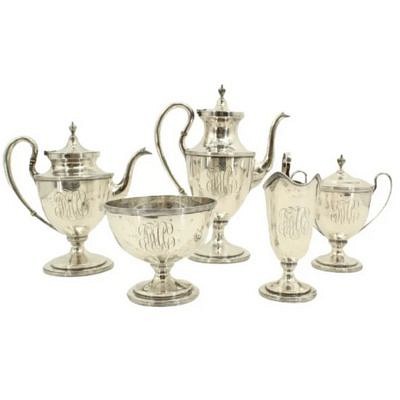Diary of Samuel Pepys, Five Volumes 1851
About Seller
522 South Pineapple Avenue
Sarasota, FL 34236
United States
Sarasota Estate Auction specializes in a wide variety of furniture, antiques, fine art, lighting, sculptures, and collectibles. Andrew Ford, owner and operator of the company, has a passion for finding the best pieces of art and antiques and sharing those finds with the Gulf Coast of Florida.
Two ways to bid:
- Leave a max absentee bid and the platform will bid on your behalf up to your maximum bid during the live auction.
- Bid live during the auction and your bids will be submitted real-time to the auctioneer.
Bid Increments
| Price | Bid Increment |
|---|---|
| $0 | $10 |
| $100 | $25 |
| $250 | $50 |
| $1,000 | $100 |
| $2,500 | $250 |
| $7,500 | $500 |
| $20,000 | $1,000 |
| $50,000 | $2,500 |
| $100,000 | $5,000 |
| $250,000 | $10,000 |
About Auction
Jan 20, 2024
Artists to include: Jorge Blanco, Leonardo Nierman, Picasso, LeRoy Neiman, Darrell Crisp, Francois Krige, Mino Delle Site, Peter Max, Edward Povey, Sky Jones, Robert Rauschenberg, and others. There are also 7 Original Charles Schulz Drawings done by Reuben Timmins, Production Cels, over 200 lots of Important Books and Manuscripts, Sterling Silver, a Jane Kostick Geometric Wooden Sculpture, Modern Design and Furniture, Fantastic Estate Jewelry, and so much more! Sarasota Estate Auction sarasotaestateauction@gmail.com
- Lot Description
This five volume set is titled "Diary And Correspondence Of Samuel Pepys, F.R.S., Secretary To The Admiralty In The Reign Of Charles II And James II, The Diary Deciphered By The Rev. J. Smith, A.M., From The Original Shorthand MS. In The Pepysian Library. With A Life And Notes By Richard Lord Braybrooke. Third Edition, Considerably Enlarged. In Five Volumes", published in London by Henry Colburn at Great Marlborough Street in 1851. Samuel Pepys (1633 - 1703) was an English diarist who served as administrator of the Royal Navy and a member of Parliament and is most famous for the diary he kept for a nearly a decade. Pepys had no maritime experience, but through patronage, diligence, and his talent for administration, rose to be Chief Secretary to the Admiralty under both King Charles II and King James II. His influence and reforms at the Admiralty were important in making the Royal Navy a competent well-organized fighting body - the professionalization of the Navy. The detailed private diary that Pepys kept from 1660 until 1669 was first published in the 19th century and is one of the most important primary sources for the English Restoration period. It provides a combination of personal revelation and eyewitness accounts of great events, such as the Great Plague of London, the Second Dutch War, and the Great Fire of London. At a young age, Pepys suffered from bladder stones in his urinary tract and was almost never without pain, as well as other symptoms like "blood in the urine" (haematuria). By the time he was married, the condition was very severe, and in 1657 Pepys decided to undergo surgery - not an easy option, because the operation was known to be especially painful and hazardous. Nevertheless, the operation took place in 1658 and Pepys's stone was successfully removed; however, there were long-term effects from the operation, and the incision on his bladder broke open again late in his life, which caused more complications. In 1660, he began to keep a diary and recorded his daily life for almost ten years. This record is more than a million words long and is often regarded as Britain's most celebrated diary, and Pepys has been called the greatest diarist of all time due to his frankness in writing about his own weaknesses and the accuracy with which he recorded events of daily British life and major events in the 17th century. Pepys wrote about the contemporary court and theatre (including his affairs with the actresses), his household, and major political and social occurrences. Historians have been using his diary to gain greater insight and understanding of life in London in the 1600's. Aside from day-to-day activities, Pepys also commented on the significant and turbulent events of his nation. England was in disarray when he began writing the diary. Oliver Cromwell had died just a few years before, creating a period of civil unrest and a large power vacuum had to be filled. Pepys had been a strong supporter of Cromwell, but converted to the Royalist cause upon Cromwell's death. He was on the ship that took Charles II back to England to take up the throne, and gave first-hand accounts of other significant events from the early years of the Restoration, such as the coronation of Charles II and the Anglo-Dutch wars. Pepys did not plan on people of his day ever seeing his diary, which is evident from the fact that he wrote in shorthand and sometimes in a "code" of various Spanish, French, and Italian words (especially when describing his illicit affairs), but he intended future generations to see the diary, as evidenced by its being included in his library and a catalogue with the shorthand guide he used and the elaborate planning he made to ensure his library survived intact after his death. Pepys stopped writing his diary in 1669 because his eyesight began to trouble him and he feared that writing in dim light was damaging his eyes. He thought about others writing the diary for him, but that would have resulted in a loss of privacy, so he never went through with those plans. In the end, Pepys lived another 34 years without going blind, but he never took to writing his diary again. The books are 3/4 bound, in fine bindings by Sangorski and Sutcliffe, with five raised bands, six compartments with gilt titles and elaborate gilt tooling on the spines, "1851" on the heel of the spine, marbled boards and marbled endpapers with the recent owner's bookplate, and "Edward R. Mitton" on one of the blank endpapers - Mitton was President of Jordan Marsh from 1937 to 1973, and he began working there in 1917. The first volume has a frontis portrait of Samuel Pepys, the second volume has frontis portrait of Elizabeth Pepys, Samuel's wife, and the third volume has a fold-out frontis of the library of Samuel Pepys - a "View of the Interior of Mr. Pepys' Library In York Building", and each volume has varying lengths. Volume I has a three-page Preface, one page for a List of Illustrations, 378 pages of text, and an Appendix that runs from 381 to 388, then a twenty-four page list of Mr. Colburn's new books for sale. Volume II has 450 pages of text, Volume III has 440 pages of text, the fourth volume has 511 pages of text, and the last volume has 424 pages of text, with a fold-out map titled "Position of The Dutch Fleets and Action … Chatham .. 1667" after the text, then an Appendix that runs from 427 to page 460, followed by a General Index that is 101 pages long and a two-sided leaf at the end about a new edition of Evelyn's Diary and Correspondence, for a total of 563 pages in the book counting the leaf at the end. The books are 8vo. and measure 7 7/8 x 5 3/8 in. wide and are in very good condition. The bindings are tight and the pages and text are very clean, with just very light rubbing along the spines and at the tips, and the books are bound by Sangorski and Sutcliffe, a top-notch binder, with a great view of English history in the seventeenth century by an author whose work commanded the respect of nearly all who knew him and read his works. #44 #5003
- Shipping Info
-
SHIPPING INFORMATION·
Sarasota Estate Auction IS NOT RESPONSIBLE FOR SHIPPING. All shipping will be handled by the winning bidder. Sarasota Estate Auction recommends obtaining shipping quotes before bidding on any items in our auctions. If you are interested in obtaining any information on local shippers, please send us an email and we will kindly send you a list of local shippers. Refunds are not offered under any circumstances base on shipping issues, this is up to the buyer to arrange this beforehand.
Premier Shipping, info@premiershipment.com
BIDDER MUST ARRANGE THEIR OWN SHIPPING. Although SEA will NOT arrange shipping for you, we do recommend our shipper Premier Shipping & Crating at info@premiershipment.com You MUST email them, please do not call. If you'd like to compare shipping quotes or need more options, feel free to contact any local Sarasota shippers. You can email any one of the shippers below as well. Be sure to include the lot(s) you won and address you would like it shipped to. Brennan with The UPS Store #0089 - 941-413-5998 - Store0089@theupsstore.com AK with The UPS Store #2689 - 941-954-4575 - Store2689@theupsstore.com Steve with The UPS Store #4074 - 941-358-7022 - Store4074@theupsstore.com Everett with PakMail - 941-751-2070 - paktara266@gmail.com
-
- Payment & Auction Policies
-
Available payment options
We accept all major credit cards, wire transfers, money orders, checks and PayPal. Please give us a call at (941) 359-8700 or email us at SarasotaEstateAuction@gmail.com to take care of your payments.
-
- Buyer's Premium



 EUR
EUR CAD
CAD AUD
AUD GBP
GBP MXN
MXN HKD
HKD CNY
CNY MYR
MYR SEK
SEK SGD
SGD CHF
CHF THB
THB































